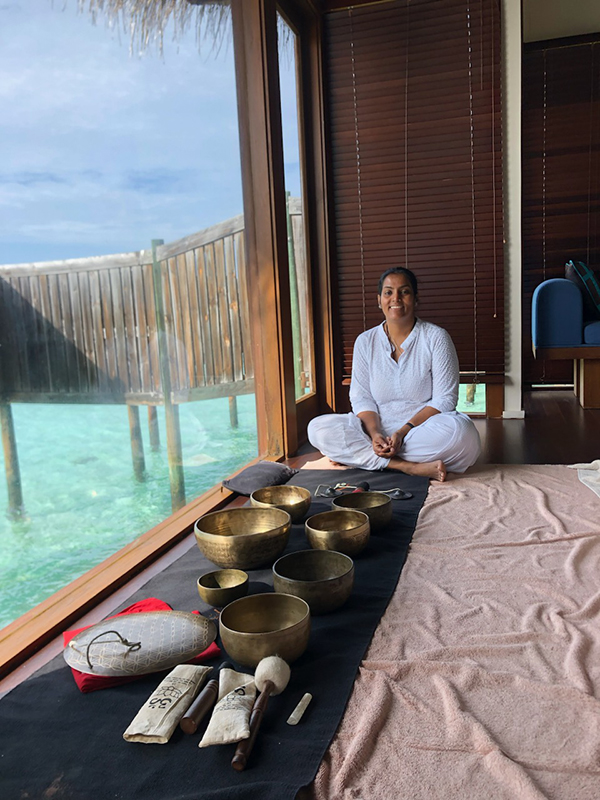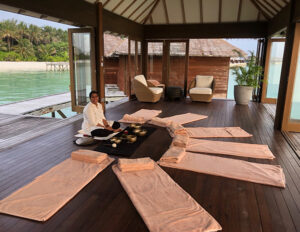
Many Pilates teachers incorporate a sensory approach into their teaching method; they consider how the senses of their students can be stimulated, calmed or brought to the fore whilst engaging in Pilates practice. They may choose to include tactile cues and other manual techniques, decorate their studios using colours and images, burn essential oils or play music or sounds – all of which can have a considerable impact on the physical, mental and emotional state of the student.
When I teach Pilates at my studio, I generally do not play music or incorporate a soundscape. I prefer my clients to listen to my verbal cues and to the sound of their breath whilst coordinating it with their movements: I choose to minimise the amount of auditory distractions. However, whilst teaching Pilates classes to ballet dancers at the ballet school I work for, at specific times I do play music. By incorporating relaxing rhythms and music at the beginning of the class, whilst the students focus on breathing exercises, it helps them to successfully reset after having prior completed a high-intensity dance class. It also serves to calm them during the stretching component at the end of the class before they move on to yet another energetic dance class. My choice about whether to combine the use of a soundscape or not is specific to what I am hoping to achieve.
What is sound?
The Merriam-Webster Dictionary defines sound as being “the sensation perceived by the sense of hearing”. Their choice of the word ‘sensation’ is perhaps used to reinforce that sound is related to the auditory sensations caused by hearing, or it could be to imply that sounds cause sensations within our bodies – either way, we cannot discount how what we hear affects what we sense on many levels.
Another widely used definition of sound is that it is a series of vibrations that travel through air and water which, once having reached our intelligent bodies, is interpreted by us in some way or another. Obviously, it is something we hear via our auditory sense but it is also something that can be seen if its wave-like structure and frequency are transcribed visually. If our vision were more astute, we may even be able to see it travelling through the air – what a treat that would be!
The impact sounds and vibrations have on humans, animals and plants is yet to be fully understood. There are researchers in this field who explore the impact it has on specific life forms and some studies have even discovered that plants may emit and receive sounds to communicate with insects and amongst themselves. Perhaps the philosophy ‘play Mozart to your plants to help them grow’ runs true indeed. Whatever our opinion, many would agree that the power of sound is great.
Not all sounds work their magic the same way. For most, hearing loud screaming or the rumbling sound of an engine whilst we are trying to be ‘Zen’ is somewhat distressing, yet listening to cascading waves or a soothing piece of music is pleasant. Of course, our preferences are personal, though most would agree that sounds influence how we experience emotions, thoughts, our physical state and spiritual or religious practices.
That being so, certain sounds often form an integral part of many therapeutic practices such as Pilates, yoga, meditation and other activities that promote our well-being. One practice that uses sound as its primary tool to promote wellness is often referred to as ‘sound therapy’ or ‘sound healing’. Both focus on the auditory sense and use this channel to improve our state-of-being.
Sound therapy and sound healing
I am not an expert in the field of sound therapy nor sound healing; this is the domain of specialised practitioners. However, having spent a lot of my life working with music (via my dance teaching and choreographic endeavours) I do have some experience regarding how sounds can affect the body with specific regard to physical movement.
Whilst studying my dance and choreography degrees at university, I was often required to perform movement improvisations to different soundscapes. On one occasion, I was tasked with improvising to one of Adolf Hitler’s speeches; it was such an informative experience that my memory of it is still very clear.
I recall moving abruptly and frenetically as my body expressed the tension and distress that I was feeling; the movements I created emulated my perception of Hitler’s voice. As I do not speak German, I relied on his intonation and timbre rather than a direct translation of the words he spoke. What I gleaned from this and other similar experiences was that, provided I succumbed to my auditory sense and let it move me, sounds could unravel parts of my subconscious that in turn became my conscious reality which I expressed via my body.
Clearly, sound therapy and healing, when compared to physical improvisations guided by a soundscape, are quite different. Yet they do share some common ground: both can change our experience of the present moment and alter our state.
The purpose of sound therapy and healing is varied. It is reliant upon on the facilitator’s area of expertise and the desired outcome of the session. The aim may be to heal, evoke well-being, connect with subconscious thoughts, emotions or memories, release negativity or balance our energy. This type of therapy or healing also forms an integral part of many spiritual and religious practices: indeed, some indigenous cultures have used it for thousands and thousands of years. In many cases, it can evoke a higher sense of self, a connection with a God or deities, the path towards enlightenment, create a shared experience for those engaging in it together or be a medium for telling cultural stories.
There are many forms of sound therapy and healing, each relying on different melodies, chords, rhythms, pitches and frequencies that work their wonder for those privy to hearing them. These may include the playing of tuning forks, gongs, pan flutes, singing bowls, the didgeridoo, drums, chanting, melodic music or sounds created by nature.
Healing frequencies
Some sound therapists and healers require their clients to wear headphones and attach electrodes to their bodies to investigate which sound frequency is best suited to evoking the calming Alpha and Theta waves in the patients’ brains: Alpha waves are often detectable when the eyes are closed and the mind is relaxed or during yoga practice, Theta waves are present when in deep meditation or daydreaming.
One established method focuses on ‘Solfeggio Frequencies’ (174Hz, 528Hz and 852Hz to name but a few) to balance the mind, body and spirit. These were used by Ancient Egyptians, in Ancient Sanskrit and by Medieval Gregorian monks and are believed to have a special relationship with the chakras and the energy within the body.
A 2018 Japanese study investigated the stress-reducing effect of 528Hz on the endocrine system and the autonomic nervous system and found that this frequency impacts our body’s chemical balance. The experiment was performed by playing two different soothing piano pieces to participants (one at 528Hz and the other at 440Hz) whilst they were seated and wearing a Bio Information Tracer. Salivary Biomarker testing, an electrocardiogram and a mood score questionnaire were also included in the study to shine additional light on the experiment. The results found that the 528Hz frequency lowered cortisol levels, increased oxytocin levels, decreased stress levels and improved negative mood scores; indeed, frequencies can literally fill us with happiness and peace. https://www.researchgate.net/publication/327439522_Effect_of_528_Hz_Music_on_the_Endocrine_System_and_Autonomic_Nervous_System
Chakra and aura cleansing
Earlier this year, I was extremely fortunate to engage in several group sound meditation sessions and one two-hour private session whilst on an overseas holiday. The sound healer, Sreeja Devi (www.healwithsoundtherapy.com), received her training from the Isha Yoga Centre in India and I cannot speak highly enough of her. What I experienced was beyond words, transformational and the inspiration for this article.
The group sound meditation was performed outdoors, on a platform overlooking a calm ocean and lasted approximately 30-mins. It included no more than seven participants lying supine in a semi-circle, in a fan-like configuration, heads facing the centre of the circle where Sreeja sat, together with her instruments. She explained that this was a general sound meditation that did not cater to individual needs but rather sought to enable us to experience whatever it was that would naturally occur within each of us. Singing bowls (and I believe also chimes or bells) were played as we lay still and each experienced something unique.
During my first group session, I recall very strongly disliking some of the earlier sound frequencies and very much wanting them to stop. Sreeja later told me that when working one-on-one she first conducts an aura and chakra assessment and then chooses sounds specific to the needs of the person she is working with. She also explained that certain frequencies played during the group session may not have been suited to me or, alternatively, that I may have had some blocked chakras and my feeling of discord could have been the blockage(s) releasing.
When Sreeja played sounds that I resonated with (or perhaps, by this stage, some blockages had subsided), I began to relax. The calm state I entered allowed me to clearly hear and feel their vibrations surging and flowing within me. This was accompanied by visualisations that left me rather perplexed as I had no idea from whence they came. When the session ended, I felt at ease. The sensory experience had heightened my sense of hearing so much so that when others around me began conversing just moments after it ended, I could not stand the ‘noise’ of talking. The peaceful sound of silence (some scientific scholars claim silence is a sound) was all I wanted to listen to.
After two group sessions, I booked a one-on-one private session. It differed from the group sound meditation and was unlike any other form of meditation I had previously engaged in. Although I have had some profound and other-worldly moments during meditation practices, this was in a category of its own.
During the two-hour session, I travelled to places far and wide that rendered me tranquil, sad, joyous, scared, clear-minded, confused… over and over again, in a different order, with much more thrown in. My breathing slowed so much that, at one point, I thought it would stop altogether. I later asked Sreeja why that happened and she said it typically occurs during yogic practices when practitioners enter a deep meditative state – had I known that earlier I may have saved myself a panic attack that I managed to overcome by telling myself everything was okay even when it felt like it was not.
The best way I can describe what happened is by likening it to a very difficult yet rewarding journey to an unknown place within yourself that completely unsettles you yet liberates you when you finally arrive. To this day, seven months on, the mark it left on me is impressionable. I was confronted with fears I was unaware of having, discovered places that I never have imagined and when I finally opened my eyes, I cried for a sadness unbeknownst to me. Without question, the experience altered me, my perception of myself and the universe as I understand it to be.
The overriding message I was blessed with was to ‘let go’ – not of something specific I was holding onto but rather of everything that did not serve me well. Was this conditioned by the numerous Buddhist texts I have read or my yoga practice and training? Was it based on my Roman Catholic upbringing or my mother constantly telling me to ‘let things go, Daniela’? Was it because, fundamentally, I know ‘holding on’ is one of my greatest short-comings or was it Sreeja helping me to connect with a higher sense of self or a universal energy? I do not know the answer but I do know that I am thankful for the very challenging two-hours that unnerved me greatly.
Later that day, I made a vow to myself to not heed the many things that are useless rather than useful and to accept more and resist less. I confess that I have not been entirely successful in my plight. However, when I remember to remember my vow, I am reminded of the extraordinary experience Sreeja gifted me and graciously thank her.
In this age, distractions are ashamedly plentiful, choices outnumber good reason and time seems to be something we are chasing rather than consciously remaining in as each moment unfolds. Perhaps we should spend more of it listening: to ourselves, to others and to the abundance of sounds that help us find the balance and harmony required to live and serve other sentient beings, and our marvellous planet, well.
Daniela Di Fabio, PAA Committee



Comments are closed.